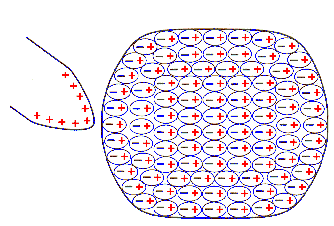
Charged objects exert forces on each other. But even objects that have no net charge can be acted on by electrical forces. Consider the case of a neutral insulator placed close to a positively charged rod, as shown in the figure below.

The electrons in the insulating material are bound to their atomic nuclei. They are not free to move throughout the material. But the electric field produced by the positive charges on the rod attracts the electrons and repels the nuclei. The electrons are therefore no longer symmetrically distributed around their nuclei, but are pulled over to the side closer to the rod. The net effect is that the entire negative charge is displaced by a small amount with respect to the positive charge in the material. This results in an effective surface charge density, which is negative on the side close to the rod and positive on the side farther away from the rod. This is the phenomenon of electrical polarization. The field of the rod decreases with distance, so the attractive force on the negative surface charge is stronger than the repulsive force on the positive surface charge. The material is attracted towards the rod due to its polarization.
If, instead of an insulator, we have a conductor, then an excess of free electrons gathers on the side close to the rod, and the side farthest away from the rod is depleted of free electron and therefore has a net positive surface charge. Again the material is attracted towards the rod.
If we use a negatively charged rod, then electrons are repelled, and the effective surface charge density is positive on the side close to the rod and negative on the side farther away from the rod. Again the material is attracted towards the rod.
Electrical polarization always produces attraction.
Please watch this video clip. A plastic rod is rubbed and becomes positively charged through the triboelectric effect. Bringing the charged rod near the metal Coke can causes the free electrons inside the can to redistribute, a process known as electric polarization. The positively charged rod attracts the electrons in the metal to the near side, introducing a negative surface charge on the near side of the can and leaving a positive surface charge on the far side. Since the electric force between charges decreases with their separation, the overall force between rod and can is attractive. this causes the can to roll towards the rod. No charge is transferred to the rod, it remains overall neutral, but the negative charge on it is redistributed.